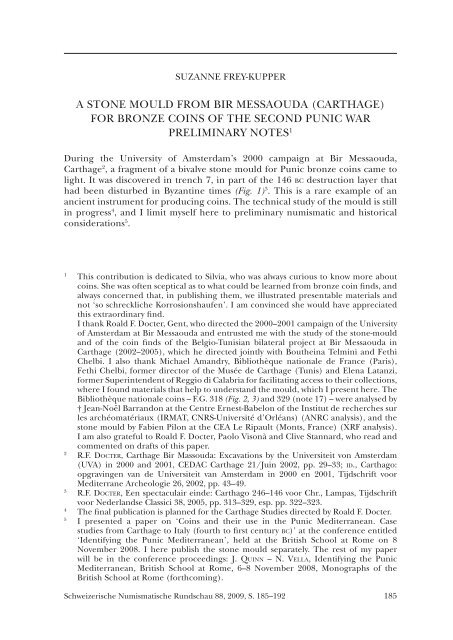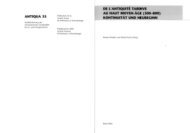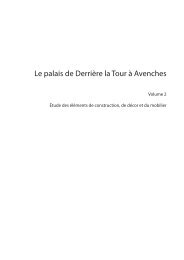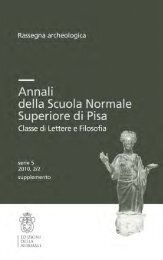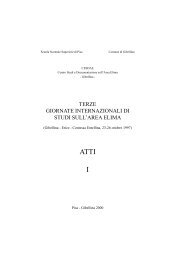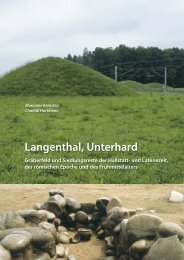a stone mould from bir messaouda - Suzanne Frey-Kupper
a stone mould from bir messaouda - Suzanne Frey-Kupper
a stone mould from bir messaouda - Suzanne Frey-Kupper
You also want an ePaper? Increase the reach of your titles
YUMPU automatically turns print PDFs into web optimized ePapers that Google loves.
SUZANNE FREY-KUPPER<br />
A STONE MOULD FROM BIR MESSAOUDA (CARTHAGE)<br />
FOR BRONZE COINS OF THE SECOND PUNIC WAR<br />
PRELIMINARY NOTES 1<br />
During the University of Amsterdam’s 2000 campaign at Bir Messaouda,<br />
Carthage 2 , a fragment of a bivalve <strong>stone</strong> <strong>mould</strong> for Punic bronze coins came to<br />
light. It was discovered in trench 7, in part of the 146 bc destruction layer that<br />
had been disturbed in Byzantine times (Fig. 1) 3 . This is a rare example of an<br />
ancient instrument for producing coins. The technical study of the <strong>mould</strong> is still<br />
in progress 4 , and I limit myself here to preliminary numismatic and historical<br />
considerations 5 .<br />
1 This contribution is dedicated to Silvia, who was always curious to know more about<br />
coins. She was often sceptical as to what could be learned <strong>from</strong> bronze coin finds, and<br />
always concerned that, in publishing them, we illustrated presentable materials and<br />
not ‘so schreckliche Korrosionshaufen’. I am convinced she would have appreciated<br />
this extraordinary find.<br />
I thank Roald F. Docter, Gent, who directed the 2000–2001 campaign of the University<br />
of Amsterdam at Bir Messaouda and entrusted me with the study of the <strong>stone</strong>-<strong>mould</strong><br />
and of the coin finds of the Belgio-Tunisian bilateral project at Bir Messaouda in<br />
Carthage (2002–2005), which he directed jointly with Boutheina Telmini and Fethi<br />
Chelbi. I also thank Michael Amandry, Bibliothèque nationale de France (Paris),<br />
Fethi Chelbi, former director of the Musée de Carthage (Tunis) and Elena Latanzi,<br />
former Superintendent of Reggio di Calabria for facilitating access to their collections,<br />
where I found materials that help to understand the <strong>mould</strong>, which I present here. The<br />
Bibliothèque nationale coins – F.G. 318 (Fig. 2, 3) and 329 (note 17) – were analysed by<br />
† Jean-Noël Barrandon at the Centre Ernest-Babelon of the Institut de recherches sur<br />
les archéomatériaux (IRMAT, CNRS-Université d’Orléans) (ANRC analysis), and the<br />
<strong>stone</strong> <strong>mould</strong> by Fabien Pilon at the CEA Le Ripault (Monts, France) (XRF analysis).<br />
I am also grateful to Roald F. Docter, Paolo Visonà and Clive Stannard, who read and<br />
commented on drafts of this paper.<br />
2 R.F. Docter, Carthage Bir Massouda: Excavations by the Universiteit von Amsterdam<br />
(UVA) in 2000 and 2001, CEDAC Carthage 21/Juin 2002, pp. 29–33; iD., Carthago:<br />
opgravingen van de Universiteit van Amsterdam in 2000 en 2001, Tijdschrift voor<br />
Mediterrane Archeologie 26, 2002, pp. 43–49.<br />
3 R.F. Docter, Een spectaculair einde: Carthago 246–146 voor Chr., Lampas, Tijdschrift<br />
voor Nederlandse Classici 38, 2005, pp. 313–329, esp. pp. 322–323.<br />
4 The final publication is planned for the Carthage Studies directed by Roald F. Docter.<br />
5 I presented a paper on ‘Coins and their use in the Punic Mediterranean. Case<br />
studies <strong>from</strong> Carthage to Italy (fourth to first century bc)’ at the conference entitled<br />
‘Identifying the Punic Mediterranean’, held at the British School at Rome on 8<br />
November 2008. I here publish the <strong>stone</strong> <strong>mould</strong> separately. The rest of my paper<br />
will be in the conference proceedings: J. Quinn – n. Vella, Identifying the Punic<br />
Mediterranean, British School at Rome, 6–8 November 2008, Monographs of the<br />
British School at Rome (forthcoming).<br />
Schweizerische Numismatische Rundschau 88, 2009, S. 185–192 185
SUZANNE FREY-KUPPER<br />
186<br />
Fig. 1 Stone plaque with <strong>mould</strong>s for casting Carthaginian coins<br />
of the SNG Cop. 307–314 type, found in the 2000 campaign of<br />
the University of Amsterdam at Bir Messaouda (Carthage).<br />
The <strong>mould</strong> is of a yellowish lime<strong>stone</strong>. The coin-negatives are disposed in three<br />
rows of at least four very shallow circles (c. 0.7mm deep), each of a diameter of<br />
c. 20mm. Six of the twelve negatives are fragmentary. They almost touch each<br />
other, and are connected by runnels. At the lower edge of the <strong>mould</strong>, the casting<br />
flues of the middle and right row of coins are clearly visible 6 .<br />
In the central remaining <strong>mould</strong>, the negatives letters, aleph before, and sade<br />
below the horse, are preserved (Fig. 2, 1). This shows that at least this negative<br />
served to cast coins similar to SNG Cop. 309–313 (Fig. 2, 2) 7 . Other negatives bear<br />
no letters, which could mean that the carving of the negatives was not finished<br />
when the <strong>mould</strong> was lost, or thrown away. The latter may be more likely, as the<br />
broken edges of the <strong>mould</strong> are not fresh.<br />
6 Hans Koens and Roel Janssen, Amsterdam, studying the casting technique, suggest that<br />
these flues were part of a ‘lost-wax’ process, in which, they believe, wax positives were<br />
cast, which were then sprued up in trees, and cast in bronze.<br />
7 G.K. Jenkins, Sylloge Nummorum Graecorum Copenhagen, fasc. 42, North Africa:<br />
Syrtica – Mauretania (Copenhagen, 1969), hence SNG Cop.
A STONE MOULD FROM BIR MESSAOUDA (CARTHAGE) FOR<br />
BRONZE COINS OF THE SECOND PUNIC WAR. PRELIMINARY NOTES<br />
1 2 3<br />
Fig. 2 (1) Detail of an individual coin-negative with letters in<br />
negative (alef before and sade below the horse), as in SNG<br />
Cop. 309–313; (2) A struck example of SNG Cop. 309–313;<br />
(3) A cast coin of the same type, with no visible letters;<br />
the remains of the casting runnel are visible on the<br />
reverse below the horse’s legs.<br />
Depending on the letters that were cut into the negatives, the types for which<br />
the <strong>mould</strong> could have been intended range <strong>from</strong> at least SNG Cop. 307 to 314, and<br />
possibly to 323. They can be dated by the coins over which they were occasionally<br />
struck: litrai of the Fifth Syracusan Democracy (Fig. 3, 1) 8 , and Roman unciae<br />
issued by a Sicilian mint (Fig. 3, 2) 9 , both of the years 214–212 bc, as well as litrai<br />
of Hieron II of Syracuse (240–215 bc) 10 , which were also overstruck by Roman<br />
sextantes of 211–209 bc 11 . These overstrikes provide a terminus post quem of 214 bc.<br />
We can be more precise. The coins overstruck with Punic types that are found<br />
in Carthage and nearby came <strong>from</strong> Sicily, and the overstrikes are rarely found in<br />
Italy: they must therefore be part of the booty of Carthage’s Sicilian expedition<br />
of 213–211 bc 12 . This suggests a slightly later terminus, of 213 bc 13 .<br />
8 Sylloge Nummorum Graecorum. The Royal Collection of Coins and Medals. Danish<br />
National Museum.Vol. I: Italy – Sicily (Copenhagen, 1942), no. 891.<br />
9 RRC, p. 153, no. 42/4.<br />
10 E. Gàbrici, La monetazione del bronzo della Sicilia antica (Palermo, 1927), pp. 184–185,<br />
nos. 442–489.<br />
11 RRC, p. 69, no. 69/6. For Carthaginian overstrikes in general, see Ch.A. HersH,<br />
Overstrikes as evidence for the history of Roman Republican coinage, NC 13, 1953, pp.<br />
33–68, esp. 43; and RRC, p. 106 and CMRR, p. 336, though neither RRC nor CMRR list<br />
examples of our overstrikes. See however P. Visonà, Carthaginian coinage in perspective,<br />
AJN, Second Series 10, 1998, pp. 1–27, esp. pp. 17–18.<br />
12 Visonà (above, n. 11), p. 17.<br />
13 For a date in the years around 212–211 bc, and for the mint, see G.K. Jenkins, Some coins<br />
of Hannibal’s time, BdN 4, Suppl. [Studi per Laura Breglia] 1978, pp. 215–234, esp.<br />
pp. 216–217; D. kienast, Ein punischer Münzfund aus Tunis, SM 15, 1965, pp. 25–29<br />
(a hoard buried between 204 and 201 bc).<br />
187
SUZANNE FREY-KUPPER<br />
188<br />
1 2<br />
Fig. 3 Punic bronze of the Second Punic War struck over coins<br />
of 214–212 bc: (1) A litra of the Fifth Syracusan Democracy;<br />
(2) A Roman uncia, <strong>from</strong> a Sicilian mint.<br />
A second argument derives <strong>from</strong> a group of coins found at Torre del Mordillo<br />
near Cosenza in Calabria, which includes a number of coins of the Second Punic<br />
War, among which, two Punic coins produced in Southern Italy (Fig. 4, 1 & 2),<br />
and two struck coins of the <strong>mould</strong> type, one over a Roman uncia (Fig. 4, 3 & 4) 14 .<br />
At least Fig. 4, 3 is of SNG Cop. 309–313. Although the coins were not found<br />
in a sealed stratum, it is almost certain that they were lost during the last of<br />
Hannibal’s campaigns in Southern Italy, before Scipio invaded North Africa in<br />
204 bc; this gives a clue for the date of the cast Carthaginian coins 15 , which may<br />
therefore belong to the latest phase of the war.<br />
Cast coins of this type were until now virtually unknown and have never been<br />
discussed, but, on the evidence of this <strong>mould</strong>, I made the happy discovery, in the<br />
trays of the Cabinet des médailles de la Bibliothèque nationale de France in Paris,<br />
of a coin of this type, with the typical diagnostic feature of a cast coin, namely the<br />
remains of the casting runnel on the reverse, and a sharp border (Fig. 2, 3). The<br />
coin is very thin, and weighs only 4.35 g, which is low compared to specimens of the<br />
struck type, which weigh between c. 5.1 and 8.6g 16 . The <strong>mould</strong> and the Bibliothèque<br />
nationale coin were both analysed: while no remains of metal were detected in the<br />
14 O.C. colburn, Torre del Mordillo (Cosenza). – Scavi negli anni 1963, 1966 e 1967, NSc<br />
31, 1977, pp. 423–526, esp. p. 526, C 73 (SNG Cop., nos. 370–371); C 74 (SNG Cop., nos.<br />
372–374); C 75 (SNG Cop., nos. 309–313); C 84 (SNG Cop., nos. 307–323 – possibly<br />
nos. 317–319, the variant with the palmette standard – struck over RRC, p. 153, no. 42/4).<br />
I thank Paolo Visonà, who drew my attention to this group of coins.<br />
15 One of them (C 73, here Fig. 4, 1) was however found in a context of the Second Punic<br />
War, cf. colburn (above, n. 14), pp. 456–457. Other coin finds containing Punic types<br />
of Southern Italy attest also to Hannibal’s campaign, cf. P. Visonà, La monetazione<br />
annibalica in bronzo nel Bruzio, Klearchos 129–136, 1991–1992, pp. 149–160, esp. pp.<br />
152–153.<br />
16 kienast (above, n. 13), p. 27.
A STONE MOULD FROM BIR MESSAOUDA (CARTHAGE) FOR<br />
BRONZE COINS OF THE SECOND PUNIC WAR. PRELIMINARY NOTES<br />
1 2 3 4<br />
Fig. 4 Punic coins of the Second Punic War, <strong>from</strong> Torre del<br />
Mordillo near Cosenza, Calabria: (1 & 2) Uncertain mint of<br />
Southern Italy, unit and half-unit, 215–205 bc; (3 & 4) Carthage,<br />
214–204 bc (no. 4 is struck over a Roman uncia of 214–212 bc).<br />
<strong>mould</strong>, the cast coin has a lead-content of 41%, which is much higher than the<br />
c. 9% in a struck coin of the same type 17 . The low weight is undoubtedly a sign of<br />
the economic crisis at the end of the war, and the high lead content might also be<br />
understandable as an economy, although the alloy may also have been used for<br />
technical reasons, as it lowers the melting point and facilitates casting 18 .<br />
There is little evidence for the use and the status of these coins. We also do not<br />
know if their production overlapped with or followed the production of struck<br />
coins. The only known find containing cast coins is the now dispersed (and<br />
probably incomplete) hoard seen in Tunisia in 1976–1977 and subsequently in<br />
commerce 19 : it contained 36 struck specimens of the type SNG Cop. 302–325 and<br />
four of the type SNG Cop. 326–329(?), as well as ‘8 cast imitations of type with<br />
horse r. head reverted [i.e. SNG Cop. 302–325]’.<br />
The find shows that cast and struck SNG Cop. 302–325-type coins circulated<br />
and were hoarded together. This suggests that the cast coins were accepted<br />
in daily exchanges, and there is no reason, in my view, to consider them<br />
17 Bibliothèque nationale de France F.G. 318, 10.87g. More analyses will of course be<br />
necessary, in order to have a representative series of results that provide a clear picture<br />
of the alloy used for the leaded bronze of the type discussed.<br />
18 See, similarly, s. <strong>Frey</strong>-kupper – J.-n. barranDon, Analisi metallurgiche di monete antiche<br />
in bronzo circolanti nella Sicilia occidentale 2003, in: A. corretti (ed.), Quarte giornate<br />
internazionali di studi sull’area elima (Erice, 1–4 Dicembre 2000). Atti (Pisa, 2003),<br />
pp. 510–511. Lead, a by-product of silver production, was much cheaper than copper<br />
or tin.<br />
19 Coin Hoards IV, p. 16, no. 45. No photographs of the coins are available.<br />
189
SUZANNE FREY-KUPPER<br />
merely as counterfeits. It is probable that they were made by the Carthaginian<br />
monetary authorities themselves 20 , in order to supply small coin in the difficult<br />
circumstances of the final period of the war against Rome 21 . If this was not the<br />
case, and they were produced by private persons, this was probably due to the<br />
inability of the state to supply adequate coinage for a still functioning commercial<br />
economy. If so, their presence in the hoard shows that they were at least tolerated<br />
in circulation, and were probably accepted by the authorities 22 .<br />
20 The locality where the <strong>stone</strong> <strong>mould</strong> was found – Bir Messaouda – may support this<br />
presumption. Boutheina Maraoui Telmini, F. Chelbi and Roald F. Docter, whom I thank<br />
for this information, suggest that Bir Messaouda is near where the Magonides’ Agora<br />
was; cf. b. Maraoui telMini – F. cHelbi – R.F. Docter, Les fouilles Tuniso-Belges du<br />
Terrain Bir Massouda (2002–2005): contribution à la connaissance de la topographie<br />
de Carthage à l’époque archaïque, in A.-M. arruDa (ed.), Proceedings of the VIth<br />
Congress of Phoenician and Punic Studies, Lisbon, 25 September – 1 October 2005)<br />
(forthcoming). The proximity of the find-spot to this public area would fit better with<br />
official production than counterfeiting.<br />
21 Large precious metal denominations were no longer being produced, and the existing<br />
stock and new issues of electrum and silver coin were mostly exported to finance the<br />
war. The local economy mainly depended on bronze coins, supplemented by some rare<br />
and debased issues in precious metal (mainly electrum and billon); see Visonà (above,<br />
n. 11), pp. 16–19; see also Jenkins (above, n. 13), Visonà (above 15) and Paolo Visonà’s<br />
contribution in this volume.<br />
22 The following references discuss various aspects of the production and economic role<br />
of imitative and unofficial coinages in the ancient world. For the late Republic, see<br />
M.H. crawForD, Unofficial imitations and small change under the Roman Republic,<br />
AIIN 29, 1982, pp. 139–164; C. stannarD – S. <strong>Frey</strong>-kupper, ‘Pseudomints’ and small<br />
change in Italy and Sicily in the Late Republic, AJN 20, 2008, pp. 351–404, esp.<br />
381–384; eiD., Les imitations pseudo-Ebusus/Massalia en Italie centrale. Typologie et<br />
structure, présence dans les collections et dans les trouvailles de France, RN 166, 2010<br />
(forthcoming). For the later third century aD, see M. peter, Imitation und Fälschung in<br />
römischer Zeit, in: A.-F. auberson – H.R. DerscHka – S. <strong>Frey</strong>-kupper (eds.), Fälschungen –<br />
Nachahmungen – Imitationen. Sitzungsbericht des vierten internationalen Kolloquiums<br />
der Schweizerischen Arbeitsgemeinschaft für Fundmünzen (Martigny, 3.–4. März<br />
2002) (UNG 5) (Lausanne, 2004), pp. 19–30, esp. pp. 24–28; D.G. wiGG-wolF, Zur<br />
Interpretation und Bedeutung der „Barbarisierungen“ der römischen Kaiserzeit, in:<br />
ibid. (UNG 5) (Lausanne, 2004), pp. 55–75, esp. pp. 72–74.<br />
190
A STONE MOULD FROM BIR MESSAOUDA (CARTHAGE) FOR<br />
BRONZE COINS OF THE SECOND PUNIC WAR. PRELIMINARY NOTES<br />
Abstract<br />
A fragment of a bivalve <strong>stone</strong> coin-<strong>mould</strong> for Punic bronzes discovered during<br />
the 2000 excavations of the Amsterdam University team at Bir Messaouda<br />
(Carthage) is presented and discussed. The possible types for which the <strong>mould</strong><br />
was prepared range <strong>from</strong> SNG Cop. 307–314, and possibly also 315–323. They<br />
include at least coins similar to SNG Cop. 309–313, with aleph before, and sade<br />
below the horse. They date of the latest phase of the second war against Rome,<br />
were probably produced to meet the needs of small change in a difficult period,<br />
and attest to a still functioning local economy.<br />
A cast coin conserved at the Bibliothèque nationale de France in Paris, and a<br />
now dispersed hoard discovered in 1976–1977 in Tunisia that included both<br />
struck and cast bronzes of this type, provide further evidence for the existence<br />
and use of cast coins produced by <strong>mould</strong>s of this type.<br />
Résumé<br />
La présente contribution commente un fragment de moule en pierre découvert en<br />
2000, lors des fouilles archéologiques de l’Université d’Amsterdam à Bir Messaouda<br />
(Carthage). Le moule bivalve a servi au coulage de monnaies puniques en bronze<br />
des types SNG Cop. 307–314 et peut-être 315–323, mais en tout cas de pièces<br />
similaires à SNG Cop. 309–313 avec aleph devant et sade sous le cheval. Elles datent<br />
de la dernière phase de la deuxième guerre contre Rome et ont probablement été<br />
produites pour faire face au besoin en numéraire pendant cette période difficile,<br />
témoignant par là même d’une économie locale toujours en fonction.<br />
L’existence et l’usage de monnaies coulées au moyen de moules semblables à<br />
celui discuté sont attestés par une pièce conservée à la Bibliothèque nationale<br />
de France à Paris ainsi que par un trésor – aujourd’hui dispersé – mis au jour en<br />
Tunisie en 1976–1977, et contenant des exemplaires en bronze de ce même type,<br />
à la fois frappés et coulés.<br />
<strong>Suzanne</strong> <strong>Frey</strong>-<strong>Kupper</strong><br />
17, rue du Village<br />
CH-1408 Prahins<br />
suzanne.frey@sunrise.ch<br />
191
SUZANNE FREY-KUPPER<br />
Key to Figures 1–4:<br />
Fig. 1 University of Amsterdam, campaign. 2000, trench 7. Carthage, Musée<br />
de Carthage, inv. BM00/7052, 12115; size: 8.63 x 8.08 cm (max.) and<br />
2.23–2.74 cm thick.<br />
Fig. 2 (1) Detail of the <strong>mould</strong> in Fig. 1, showing the negative of a single coin<br />
as SNG Cop. 309–313; (2) SNG Cop. 309–313, struck original. Carthage,<br />
Musée de Carthage, 5.34g, 360°; (3) SNG Cop. 307–314 (type, no letters<br />
visible), Paris, Bibliothèque nationale de France, cast coin, FG 329, 4.35g,<br />
360°.<br />
Fig. 3 (1) SNG Cop. 315–316 (type) with beth to r. and star above, cf. Jenkins,<br />
BdN 4, Suppl. [Studi per Laura Breglia] 1978, p. 225, no. B12, struck<br />
over SNG Cop. Sicily, no. 891. Paris, Bibliothèque nationale de France,<br />
1979–152, 6.80g, 360°; (2) SNG Cop., 315–316 (type)? with beth to r.<br />
and no symbol visible above, struck over RRC, p. 153, no. 42/4. Paris,<br />
Bibliothèque nationale de France, 1979–149, 5.68g, 360°; both coins<br />
belong to a lot of coins (1979–144–152, cf. registre d’entrée, cote 98c)<br />
acquired by G. Le Rider in 1979. Most of them, at least 1979–149–152 (all<br />
overstrikes), seem to be part of a hoard. They have a similar patina.<br />
Fig. 4 (1) SNG Cop. 370–371, <strong>from</strong> Torre del Mordillo. Reggio di Calabria,<br />
Museo Regionale, 9.77g, 360°; (2) SNG Cop. 372–374, <strong>from</strong> Torre del<br />
Mordillo. Reggio di Calabria, Museo Regionale, 6.50g, 90°; (3) SNG Cop.<br />
309–313, <strong>from</strong> Torre del Mordillo. Reggio di Calabria, Museo Regionale,<br />
6.40g, 360°; (4) SNG Cop. 307–323 (possibly 317–319), <strong>from</strong> Torre del<br />
Mordillo, struck over a Roman uncia RRC, p. 153, no. 42/4. Reggio di<br />
Calabria, Museo Regionale, 3.50g, 360°.<br />
192


